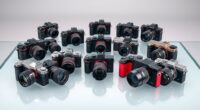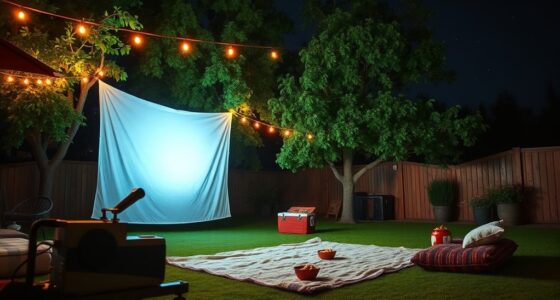Begin your map-making adventure by blending artistic style with storytelling to craft your own real or fantasy map. Focus on creating a visual aesthetic that reflects the mood and narrative you want to tell—whether whimsical, realistic, or mysterious. Use thoughtful symbols, terrains, and labels to guide viewers and enhance the story. Keep a balance between beauty and clarity, ensuring your map invites exploration. Continue exploring to discover how to bring your map’s world fully to life.
Key Takeaways
- Choose a consistent visual style that matches your map’s theme, such as fantasy, vintage, or realistic.
- Prioritize clarity and balance between aesthetic appeal and functional storytelling elements.
- Incorporate thematic symbols, labels, and textures to evoke atmosphere and guide viewer interpretation.
- Use color palettes thoughtfully to enhance mood, highlight key features, and improve visual hierarchy.
- Draw inspiration from various sources, including anime or historical maps, to create unique, immersive designs.

Have you ever wondered what it’s like to create your own map from scratch? Crafting a map is more than just drawing lines and symbols; it’s about shaping a visual story that invites others into your world. When you start designing, one of your first considerations is how to achieve compelling map aesthetics. This involves choosing the right style, color palette, and level of detail to make your map visually appealing and easy to interpret. Whether you prefer a hand-drawn, vintage look or a sleek, modern design, your map’s aesthetic sets the tone and mood for the story you want to tell. Think about how different textures, fonts, and shading can evoke the atmosphere of your fictional domain or real-world location. Good map aesthetics aren’t just eye candy—they help guide viewers’ eyes to important areas, making navigation intuitive and enhancing the overall experience. Additionally, understanding the best anime movies can inspire creative visual styles for your map, enriching its storytelling aspect.
Creating a map involves choosing styles and details that tell a compelling visual story.
But beyond visuals, your map serves as a storytelling element in itself. Every line, symbol, and label contributes to the narrative you’re creating. For a fantasy map, mountains, forests, and rivers don’t just exist—they tell stories about the land’s history, its dangers, and its inhabitants. Are you designing a map for an epic quest? You might include mysterious ruins or secret passages that hint at hidden lore. If you’re mapping a real place, the geography can reflect historical events or cultural significance. Your choices in how you depict terrain, settlements, and landmarks shape how viewers interpret the story behind the map. It becomes a visual language, communicating more than just geography—it tells a tale.
As you draw, you’ll want to think about how each storytelling element interacts with the map’s overall aesthetic. A whimsical style might suit a fairy-tale setting, with curvy lines and playful icons, while a more realistic approach demands precise, scaled features. Incorporate symbols and labels that add depth, such as castles, trade routes, or mystical sites, to enrich the narrative. The placement of these elements can also suggest movement and relationships, guiding viewers through your story without words. Every choice you make should reinforce the story you’re telling, making your map a dynamic part of your creative universe.
Ultimately, designing a map is about balance. You want it to be beautiful enough to catch the eye but also functional enough to tell a clear, engaging story. By carefully considering map aesthetics and storytelling elements, you craft a piece that’s not just a navigational tool but an immersive gateway into your world. Whether you’re mapping a fantasy kingdom or charting real terrain, your map becomes a narrative device—one that invites others to explore, discover, and imagine alongside you.
Frequently Asked Questions
What Tools Are Best for Beginner Map Makers?
As a beginner map maker, you should start with simple tools like pencil, paper, and basic digital software like Inkarnate or Wonderdraft. Focus on learning map symbolism and experimenting with color palettes to create visual interest. These tools help you understand layering, symbols, and color schemes, making your maps clearer and more engaging. As you improve, you can explore more advanced options to enhance your skills further.
How Do I Create Realistic Terrain Features?
To create realistic terrain features, start by studying real-world examples and considering terrain erosion and climate effects. Use varied shading and textures to mimic hills, valleys, and coastlines, reflecting erosion patterns. Incorporate climate influences like snow-capped peaks or arid deserts. Adjust elevation gradients gradually for natural shiftings. This approach makes your maps more authentic, helping viewers understand how climate and erosion shape the landscape over time.
Can I Incorporate Storytelling Into My Maps?
Yes, you can incorporate storytelling into your maps through narrative integration and visual storytelling. Use symbols, landmarks, and terrain features to hint at history, legends, or culture, making your map more engaging. Create areas that tell a story—like a ruined castle or mystical forest—so viewers can imagine the adventures or history behind them. This approach makes your map not just functional, but also a enthralling visual narrative.
What Are Common Mistakes in Fantasy Map Design?
You might overlook common mistakes in fantasy map design, such as inconsistent fantasy geography, which makes your world confusing, or unclear map symbolism, that leaves viewers guessing. Always double-check that your terrain features match the culture and story, and use consistent symbols for forests, mountains, and rivers. Avoid cluttering the map, and keep your legend simple to guarantee clarity. These steps help you create immersive, believable fantasy maps.
How Do I Add Depth and Shading to My Maps?
To add depth and shading to your maps, you should use layering techniques to build up different shades gradually. Start with light shading and gradually darken areas to create a sense of dimension. Use shading methods like hatching or blending to emphasize terrain features, shadows, and highlights. This approach makes your map look more realistic and engaging, giving it a three-dimensional feel that draws viewers in.
Conclusion
As you complete your map-making adventure, remember that nearly 60% of popular fantasy worlds are inspired by real-world geography. This shows how our love for storytelling is deeply connected to our curiosity about actual places. Whether drawing real or fantasy maps, you’re blending imagination with reality, creating worlds that inspire others to explore. Keep exploring your creativity—your maps could inspire the next great adventure, both in stories and in real life.










